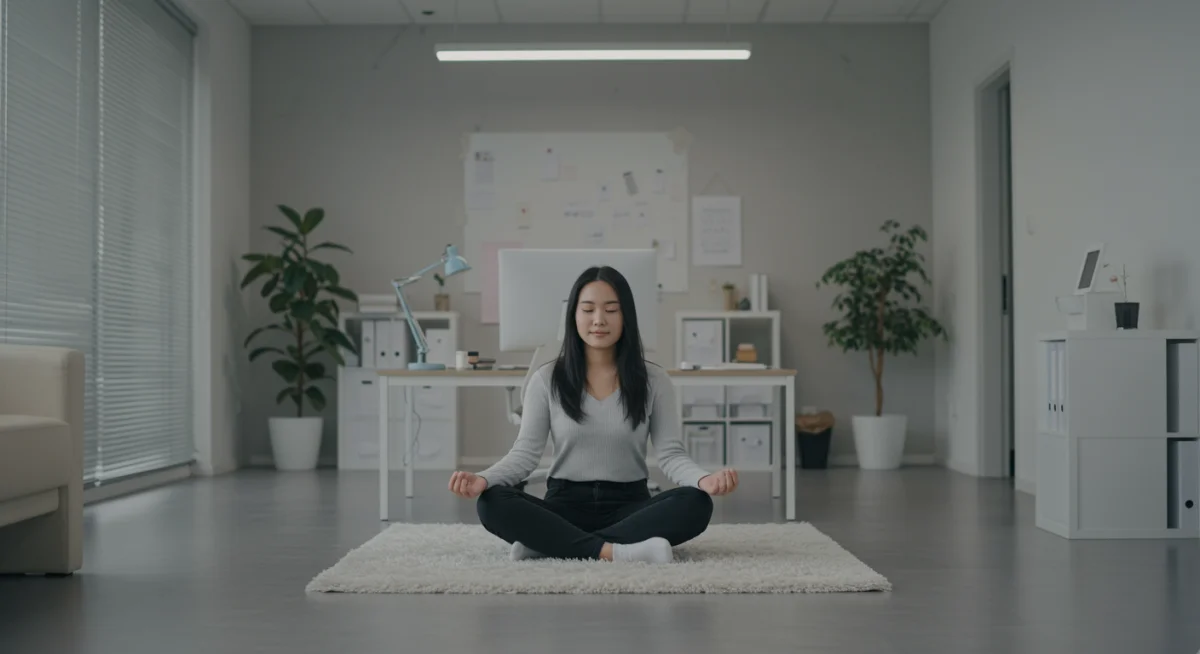3-Month Blueprint: Resilience Against Workplace Stress 2025

This 3-month blueprint offers a comprehensive, step-by-step guide to building lasting resilience against workplace stress in 2025, providing practical and actionable solutions for enhanced mental wellness and sustained professional well-being.
In today’s fast-paced professional landscape, developing workplace stress resilience is not just beneficial, it’s essential for sustained mental well-being and career longevity. This guide presents a practical 3-month blueprint designed to equip you with the strategies and habits needed to navigate the pressures of 2025 and beyond effectively.
Understanding the Landscape of Workplace Stress in 2025
Workplace stress has evolved beyond simple demanding deadlines. In 2025, it encompasses a complex interplay of technological overload, blurred work-life boundaries, economic uncertainties, and the lingering effects of global shifts. Recognizing these multifaceted stressors is the first step toward developing effective resilience strategies.
The digital age, while offering unprecedented connectivity, often leads to an ‘always-on’ culture, where expectations for immediate responses can erode personal time and foster constant anxiety. Furthermore, the rapid pace of technological change necessitates continuous learning, adding another layer of pressure. Understanding these unique pressures is critical for developing targeted interventions.
The New Normal: Digital Demands and Work-Life Blur
The integration of technology into every aspect of our professional lives means that the workday rarely ends when we leave the office. Emails, messages, and notifications often spill into personal hours, making it challenging to disconnect and recharge. This constant digital tether contributes significantly to chronic stress.
- Constant Connectivity: The expectation of instant responses can lead to heightened anxiety and a perpetual sense of urgency.
- Blurred Boundaries: Work tasks often infiltrate personal time, making it difficult to establish clear distinctions between professional and private life.
- Information Overload: A continuous stream of data and communication can overwhelm cognitive capacities, leading to decision fatigue.
Acknowledging these shifts allows us to move beyond conventional stress management techniques towards more holistic and integrated approaches. It’s not just about managing workload; it’s about managing our relationship with work in an increasingly digital world.
Month 1: Foundation Building – Awareness and Self-Assessment
The first month of this blueprint focuses on building a strong foundation for resilience by fostering self-awareness and conducting an honest self-assessment of your current stress levels and coping mechanisms. You cannot effectively manage what you do not understand. This initial phase is about observation, reflection, and setting personal benchmarks.
Begin by identifying your unique stress triggers. Are they related to specific tasks, certain colleagues, or particular times of the day? Keeping a stress journal can be incredibly illuminating, revealing patterns you might otherwise overlook. This isn’t about judgment; it’s about gathering data to inform your strategy.
Identifying Personal Stress Triggers
Everyone experiences stress differently, and what overwhelms one person might be a minor inconvenience for another. Pinpointing your specific triggers is crucial. This can involve tracking your emotional responses and physical sensations throughout the workday.
- Emotional Triggers: Frustration, anger, anxiety, or sadness linked to specific work situations.
- Physical Triggers: Headaches, muscle tension, fatigue, or digestive issues that emerge during stressful periods.
- Situational Triggers: Deadlines, meetings, client interactions, or specific projects that consistently elevate your stress.
Once identified, these triggers become actionable points for intervention. Understanding ‘what’ ignites your stress response allows you to explore ‘how’ to mitigate or even prevent it.
Assessing Current Coping Mechanisms
After identifying triggers, the next step is to evaluate how you currently respond to stress. Are your coping mechanisms healthy and effective, or do they inadvertently contribute to further stress or burnout? This self-assessment includes both conscious and unconscious reactions.
Many individuals resort to unhealthy coping strategies without realizing the long-term detriment. This month is about bringing those habits to light and considering healthier alternatives. It’s an opportunity to acknowledge patterns and commit to constructive change.
The goal of Month 1 is to create a clear, personalized picture of your stress landscape. This foundational understanding will guide your efforts in the subsequent months, ensuring that the strategies you implement are tailored to your specific needs and challenges, making your journey towards resilience more effective and sustainable.
Month 2: Skill Development – Mindset and Practical Strategies
Having established awareness in Month 1, the second month shifts to actively developing skills and implementing practical strategies to build robust workplace stress resilience. This phase is about proactive intervention and cultivating a resilient mindset through deliberate practice.
Focus on adopting techniques that empower you to manage stress in real-time, rather than simply reacting to it. This includes mindfulness practices, effective time management, and learning to set boundaries. These skills, practiced consistently, will transform your daily work experience.

Cultivating Mindfulness and Emotional Regulation
Mindfulness is a powerful tool for stress reduction, allowing you to observe thoughts and feelings without judgment. Incorporating short mindfulness exercises into your day can significantly alter your stress response. Emotional regulation involves learning to manage and express your emotions constructively.
- Mindful Breathing: Practice deep breathing exercises for a few minutes daily to calm your nervous system.
- Body Scan Meditation: Regularly check in with your body to identify and release tension.
- Emotional Labeling: Acknowledge and name your emotions to gain a sense of control over them, rather than letting them control you.
These practices are not about eliminating stress but about changing your relationship with it, allowing you to respond thoughtfully rather than react impulsively. Consistency is key to seeing lasting benefits.
Implementing Effective Time Management and Boundary Setting
Poor time management and a lack of boundaries are major contributors to workplace stress. This month, prioritize learning and applying strategies that help you manage your workload efficiently and protect your personal time.
Techniques like the Eisenhower Matrix for task prioritization or the Pomodoro Technique for focused work sessions can dramatically improve productivity and reduce feelings of overwhelm. Equally important is the courage to say ‘no’ to additional tasks when your plate is full, and to communicate your availability clearly.
By mastering these practical skills, you’re not just coping with stress; you’re actively building a framework that minimizes its impact. Month 2 is about empowerment, transforming passive observation into active and effective management of your professional life.
Month 3: Integration and Sustenance – Long-Term Resilience
The final month of the blueprint is dedicated to integrating the skills learned and ensuring their sustenance for long-term workplace stress resilience. This phase moves beyond individual techniques to encompass broader lifestyle factors and the creation of a supportive ecosystem.
The goal is to embed these practices so deeply that they become second nature, forming an unshakeable foundation for your mental wellness. This includes nurturing social connections, maintaining physical health, and continuously reflecting on your progress.
Building a Supportive Network and Seeking Feedback
Human connection is a potent buffer against stress. Actively cultivate relationships with colleagues, friends, and family who can offer support, perspective, and understanding. A strong social network provides an outlet for stress and a source of encouragement.
- Peer Support: Connect with colleagues who understand your professional challenges and can offer empathy and advice.
- Mentorship: Seek out mentors who have successfully navigated similar stressors and can provide guidance.
- Personal Connections: Ensure you are nurturing relationships outside of work that provide joy and relaxation.
Additionally, regularly seek feedback on your work and well-being. Constructive criticism can help you identify areas for improvement, while positive reinforcement can boost your confidence and sense of accomplishment.
The Role of Lifestyle in Sustained Resilience
Beyond specific workplace strategies, your overall lifestyle profoundly impacts your ability to withstand and recover from stress. This month emphasizes the importance of holistic well-being, recognizing that physical and mental health are inextricably linked.
Prioritize adequate sleep, a balanced diet, and regular physical activity. These fundamental pillars of health are often the first to be neglected during stressful periods, yet they are precisely what your body and mind need to function optimally and build resilience.

Prioritizing Sleep, Nutrition, and Physical Activity
These three elements form the bedrock of physical and mental health. When any one of them is compromised, your ability to cope with stress diminishes significantly.
- Quality Sleep: Aim for 7-9 hours of uninterrupted sleep each night to allow your body and mind to repair and rejuvenate.
- Balanced Nutrition: Fuel your body with nutrient-rich foods that stabilize blood sugar and provide sustained energy.
- Regular Exercise: Engage in physical activity that you enjoy, as it’s a proven mood booster and stress reducer.
Month 3 is about solidifying these habits and integrating them into a sustainable routine. It’s about recognizing that resilience isn’t a destination but an ongoing journey, requiring continuous care and attention to your overall well-being. By the end of this month, you should feel equipped not just to manage stress, but to thrive despite its presence.
Navigating Future Challenges: Adaptability and Continuous Growth
Building workplace stress resilience is not a one-time fix but an ongoing process of adaptation and growth. As the professional landscape continues to evolve, so too must our strategies for managing its inherent pressures. This section focuses on cultivating an adaptable mindset and committing to continuous personal development.
The lessons learned over the past three months provide a robust toolkit, but the true test of resilience lies in your ability to apply and modify these tools in the face of new or unexpected stressors. Embrace a learning mindset, viewing challenges as opportunities for further growth.
Embracing Change and Learning from Setbacks
Change is inevitable, especially in the workplace. Instead of resisting it, learn to embrace it as a natural part of progress. Develop a flexible mindset that allows you to adjust your approach when circumstances shift. Setbacks are not failures but valuable learning experiences.
- Analyze Challenges: When faced with a new stressor, take time to understand its nature and potential impact.
- Reflect and Adjust: After a setback, reflect on what went wrong and what could be done differently next time.
- Seek New Information: Stay informed about industry trends and new stress management techniques to keep your toolkit updated.
This proactive approach to change and learning transforms potential stressors into opportunities for strengthening your resilience even further. It cultivates an internal locus of control, where you feel empowered to influence your reactions and outcomes.
Setting Realistic Expectations and Celebrating Progress
Part of long-term resilience involves setting realistic expectations for yourself and your work. Striving for perfection can be a significant source of stress. Instead, focus on progress, not just outcomes. Celebrate small victories along the way to maintain motivation and acknowledge your efforts.
Regularly reviewing your achievements and acknowledging the strategies that have worked well for you reinforces positive behaviors. This positive reinforcement loop is crucial for sustaining your resilience efforts over time. Remember, resilience is built incrementally, through consistent effort and self-compassion.
Integrating Resilience into Organizational Culture
While individual resilience is paramount, a truly sustainable solution to workplace stress also involves fostering a culture that supports well-being. This section explores how individuals can advocate for and contribute to a more resilient organizational environment, benefiting everyone.
An organization that prioritizes mental wellness creates a virtuous cycle: resilient employees contribute to a healthier culture, which in turn further supports individual resilience. This involves open communication, empathetic leadership, and policies that genuinely support work-life balance.
Advocating for Mental Wellness Initiatives
Don’t just be a recipient of wellness programs; be an advocate. Share your experiences and insights with management and HR to help shape more effective initiatives. Your voice can contribute to a workplace that proactively addresses stress rather than just reacting to it.
- Share Personal Successes: Demonstrate how personal resilience strategies have improved your productivity and well-being.
- Propose Solutions: Suggest new ideas for wellness programs, flexible work arrangements, or stress reduction workshops.
- Be a Role Model: Lead by example, practicing healthy boundaries and stress management techniques openly.
By actively participating in these conversations, you become an agent of change, helping to weave resilience into the very fabric of your organization. This collective effort amplifies the impact of individual strategies, creating a more supportive and sustainable work environment for all.
The Role of Leadership in Fostering Resilience
Leaders play a critical role in shaping organizational culture. Empathetic leadership, clear communication, and a genuine commitment to employee well-being can significantly reduce workplace stress. Leaders who prioritize resilience create an environment where employees feel safe, valued, and empowered.
This includes setting realistic expectations, providing adequate resources, and recognizing the signs of burnout in their teams. Ultimately, integrating resilience into organizational culture requires a shared commitment from both individuals and leadership, creating a workplace that thrives on well-being.
| Key Phase | Brief Description |
|---|---|
| Month 1: Foundation | Focus on self-awareness, identifying stress triggers, and assessing current coping mechanisms. |
| Month 2: Skill Development | Cultivate mindfulness, emotional regulation, time management, and boundary-setting skills. |
| Month 3: Integration | Integrate practices into lifestyle, build supportive networks, and ensure long-term sustenance. |
| Ongoing Adaptability | Embrace continuous learning, adapt to change, and advocate for cultural wellness. |
Frequently Asked Questions About Workplace Stress Resilience
Workplace stress resilience is the ability to effectively cope with and recover from professional challenges and pressures. It involves developing strategies to maintain mental and emotional well-being amidst demanding work environments, preventing burnout, and fostering sustained productivity and job satisfaction.
A 3-month blueprint provides a structured, progressive approach, allowing sufficient time to build self-awareness, develop new coping skills, and integrate them into daily habits. This phased learning fosters sustainable change, making resilience a deeply ingrained part of your professional and personal life.
Mindfulness helps by training your attention to stay in the present moment, reducing rumination on past stressors or anxiety about future ones. It allows for a non-judgmental observation of thoughts and emotions, enabling a calmer, more thoughtful response to stressful situations rather than an impulsive reaction.
Practical steps include clearly defining your working hours and sticking to them, communicating your availability to colleagues, learning to politely decline non-essential tasks, and creating dedicated time for personal activities. This helps prevent work from encroaching on your personal life, fostering better balance.
Organizations can support resilience through empathetic leadership, promoting work-life balance policies, offering mental wellness resources, fostering a culture of open communication, and providing training on stress management. A supportive environment significantly enhances individual capacity to cope with workplace demands effectively.
Conclusion
Building resilience against workplace stress is an ongoing journey that requires commitment, self-awareness, and the consistent application of practical strategies. This 3-month blueprint offers a comprehensive roadmap to navigate the complexities of professional life in 2025, empowering you to not only withstand pressure but to thrive amidst it. By focusing on foundational understanding, skill development, and long-term integration, you can cultivate a robust sense of well-being that benefits both your career and your personal life. Remember, your mental wellness is a valuable asset, deserving of dedicated care and continuous nurturing.





